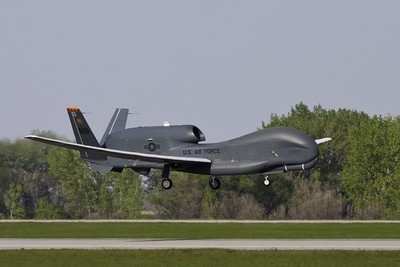Mon, Jun 06, 2011
Becomes Second UAS Main Operating Base In The U.S.
The U.S. Air Force and Northrop Grumman commemorated the arrival
of the first RQ-4 Global Hawk unmanned aircraft system (UAS) at
Grand Forks Air Force Base in North Dakota. The aircraft landed on
May 26 from Beale Air Force Base, CA. The arrival of the Global
Hawk also commemorates Grand Forks as the second main operating
base in the United States after Beale.

"Expanding the Global Hawk's mission of high altitude
intelligence, surveillance and reconnaissance in today's fight is
essential," said Brig. Gen. Paul H. McGillicuddy, 9th
Reconnaissance Wing commander. "Having this platform at Grand Forks
allows us the ability to fly more missions providing continuous
support to combatant commanders around the world."
Both Block 20 and 40 Global Hawks will be controlled from
Grand Forks. The Block 40 Global Hawk will deploy from the Grand
Forks main operating base to any location worldwide for both
military and humanitarian applications. "We are proud to celebrate
the arrival of the Global Hawk and establish Grand Forks as Global
Hawk's second main operating base," said George Guerra, HALE
Systems vice president, Northrop Grumman Aerospace Systems. "The
addition of a second main operating base will further enable Global
Hawk to provide 24/7 global coverage for both military and
humanitarian efforts."
Block 20 and 40 are alike in size, but differ in payload
configurations. The Block 40 Global Hawks are equipped with the
Northrop Grumman AN/ZPY-2 Multi-Platform Radar Technology Insertion
Program (MP-RTIP) sensor, built with teammate Raytheon Space and
Airborne Systems in El Segundo, Calif. The MP-RTIP is the first
radar sensor to concurrently usesynthetic aperture radar imaging,
while tracking moving targets simultaneously over large areas.

The RQ-4 Global Hawk flies up to 60,000 feet, above weather and
commercial air traffic. Global Hawk flies for more than 32 hours
per sortie at speeds approaching 340 knots. The MP-RTIP-equipped
Block 40 Global Hawk can persistently see through most types of
weather, day or night. As the world's first fully autonomous HALE
UAS, Global Hawk meets the global need for persistent intelligence,
surveillance and reconnaissance.
More News
Light Gun A handheld directional light signaling device which emits a brilliant narrow beam of white, green, or red light as selected by the tower controller. The color and type of>[...]
"The journey to this achievement started nearly a decade ago when a freshly commissioned Gentry, driven by a fascination with new technologies and a desire to contribute significan>[...]
Aero Linx: JAARS, Inc. For decades now, we’ve landed planes on narrow rivers and towering mountains. We’ve outfitted boats and vehicles to reach villages that rarely se>[...]
"Our driven and innovative team of military and civilian Airmen delivers combat power daily, ensuring our nation is ready today and tomorrow." Source: General Duke Richardson, AFMC>[...]
Aircraft Conflict Predicted conflict, within EDST of two aircraft, or between aircraft and airspace. A Red alert is used for conflicts when the predicted minimum separation is 5 na>[...]
 ANN's Daily Aero-Term (04.20.24): Light Gun
ANN's Daily Aero-Term (04.20.24): Light Gun Aero-News: Quote of the Day (04.20.24)
Aero-News: Quote of the Day (04.20.24) ANN's Daily Aero-Linx (04.21.24)
ANN's Daily Aero-Linx (04.21.24) Aero-News: Quote of the Day (04.21.24)
Aero-News: Quote of the Day (04.21.24) ANN's Daily Aero-Term (04.21.24): Aircraft Conflict
ANN's Daily Aero-Term (04.21.24): Aircraft Conflict




